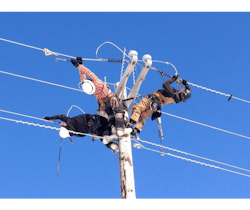Remote Areas in Alaska Benefit From Digital Utility Payments
Alaska may not be the first place that comes to mind when people think about the bleeding edge of digital transformation — and that is with good reason. The state historically has struggled to keep up with the Lower 48 when it comes to technological innovations, largely due to Alaska’s unique geography, vast size and low population density. These factors pose significant challenges to building out the infrastructure needed for mass digitization. This lack of basic infrastructure extends to all forms of digital services, from basic cell phone coverage and online education to telehealth and digital billing and payments, for example.
However, these challenges are not insurmountable. With the right strategic planning and implementation, Alaskan service providers can overcome these obstacles and propel themselves into the digital age, offering their communities the daily conveniences of technology and solutions to challenges that are unique to their lifestyle.
Addressing this lack of connectivity is a primary objective for Alaska Village Electric Cooperative (AVEC), providing service to 59 Alaskan villages and spanning the largest area of any electric power cooperative in the world. Only one of the 59 villages is connected by the road system, while the other 58 are so remote they can only be reached by boat or plane.
Given the challenging environment — which varies between mountainous regions, sprawling forests and icy tundras — one might think an electric utility upgrade would involve installing new cables or circuit boards. While AVEC is constantly problem solving for its physical infrastructure, the biggest game changer for the utility’s member services team has been overhauling the digital payments system and providing customers new options to access invoices and pay bills online.
Serving Remote Villages
Prior to June 2021, AVEC had seven customers enrolled in its automatic payment option, and it did not offer any options for paperless billing. These inadequacies would be a frustration in any environment, but for the remote villages AVEC serves, they amounted to much more than a simple inconvenience. Many people in these communities live subsistence lifestyles, meaning they depend on fishing, hunting and gathering to feed their families. That means they rely heavily on freezers to store enough meat and fish to last several months. While most people would be annoyed by a suspension in service due to a missed utility payment, for these Alaskans, the risk of having their electricity turned off is enormously consequential.
This challenge is further compounded by the fact that delinquent payments are incredibly common among AVEC customers — and not always through any fault of their own. Mail delivery to these remote villages is unpredictable at best: Harsh weather can prevent planes from landing for weeks at a time, and logistical challenges mean lost or delayed mail and parcels are common. AVEC customers in the remote villages report receiving bills late and payments getting lost in the mail. When a delinquent payment leads to an electricity shutoff, the consequences of such unreliability are severe. Families relying on subsistence hunting and fishing risk having months' worth of food go bad.
Something had to change. For AVEC, finding a digital solution to the billing issues was not just about convenience. It was about safeguarding the stability and well-being of its member communities and ensuring their way of life continues to be possible. It also was clear the member needs were as unique as they were considerable. To be successful, the digital payments solution had to be both robust and flexible, not to mention easy to use for a variety of comfort levels with technology.
Going Live
To address these challenges, AVEC took a multipronged approach: The utility invested in upgrading communications to satellite coverage for reliability and then focused on its billing system by forging partnerships with financial institutions and technology providers. Simultaneously, it conducted a comprehensive community outreach and education campaign to encourage adoption.
The utility expected to have to invest considerable time and resources encouraging adoption of the new system, but word spread fast because its benefit was so self-evident. Nearly as soon as AVEC went live with its billing partner, InvoiceCloud, its customers enrolled in paperless billing in droves. Today, it has more than 6,500 paperless bill payers. As for automatic payment, the utility increased from seven people participating in the program to 1,755 — a massive leap forward, specifically a 24,971% leap forward.
One factor AVEC’s member services team believes contributed to the utility’s success with InvoiceCloud was how it communicated about it. The team did not just communicate it was a new billing system but also a way to protect member interests and the community’s well-being. For residents who were accustomed to receiving bills late or worrying about lost payments, the ability to pay bills online or automatically was not just a matter of convenience but a crucial way to ensure their families’ safety and stability.
Digital Transformation
The difference has been nothing short of transformational. AVEC is saving more than US $20,000 per month on invoicing alone since going live with its digital billing upgrade. However, the real reward has been the impact on the community. AVEC members who had been at the mercy of the postal system — which itself is at the mercy of the weather — were no longer burdened with the anxiety of not knowing whether their power would be shut off due to a delinquent payment they knew they had made.
The psychological and emotional relief for the members cannot be understated. The adoption of digital payments provided them with peace of mind and a sense of control over their essential utilities. This transformation also helped AVEC to build stronger relationships with its customers, who now see the utility not as a service provider but as a partner in their daily lives, actively working to improve their quality of life.
Alaska is not unique in facing these challenges. Across the world, remote communities struggle with similar issues — a lack of infrastructure, challenging environments and a need for reliable services. AVEC’s experience shows digital transformation can be a powerful tool for these communities. It is not just about keeping up with the times or adopting the latest technology trends; it is about creating meaningful impact and ensuring customers can continue living their lives the way they choose.
Advancements in technology are appealing to every business. No matter the industry, seamless, straightforward tools that contribute to the bottom line are valuable assets and worth investing in. AVEC found thoughtful technology implementation can actually help to preserve heritage by supporting traditional ways of life. Ironically, by embracing digital innovation, the utility has helped Alaskans to embrace their heritage and not only survive but thrive.
Many of AVEC’s customers live lifestyles that have been handed down for generations — hunting, fishing and foraging for their food. The ability to keep their freezers running reliably and their homes warm is crucial to maintaining these traditional ways of life. The utility’s digital payment solution helps to protect this heritage by eliminating some of the risks that come with unpredictable billing cycles and unreliable postal services.
Just the Beginning
AVEC’s digital payment revolution is more than just a statistical success; it is an investment in Alaska — both its future and its history. The utility has demonstrated digital transformation can be a game changer even in the most remote and logistically challenging environments.
For other rural communities facing similar barriers, AVEC’s story can serve as an example that sometimes technology is more than a nice to have. By prioritizing digital bill payment solutions, the utility did more than modernize its technology tools. It contributed to safeguarding the way of life of its members, supporting their well-being, and enhancing their overall quality of life.
AVEC’s member services team encourages other utilities and service providers to take a page from AVEC's book and harness the power of technology to create meaningful, lasting impact. Invest in digital upgrades, collaborate with local communities and transform challenges into opportunities for growth and resilience. The future is digital, and it is time for all rural communities to seize it.
As AVEC looks to the future, it remains committed to finding new ways to leverage technology to benefit its members. The digital payment platform is just the beginning. The utility is exploring other avenues of innovation that could further enhance service reliability, reduce costs and improve the quality of life for those it serves. From smart grid technologies to renewable energy solutions, the possibilities are extensive.
With its vast landscapes and resilient communities, Alaska might not have been the first place one would think of for digital innovation. But perhaps, in this land of extremes, it is precisely where innovation matters most.
About the Author
Stacey Smith
Stacey Smith has served as manager of member services at AVEC since May 2017, after 13 years providing fuel and logistics services via other partners. Her current duties include leading the member services team and overseeing all billing, collections and management of capital credits. She also is responsible for annual meeting coordination, responding to consumer concerns and managing the complex software and metering programs that generate the cooperative’s revenue.




